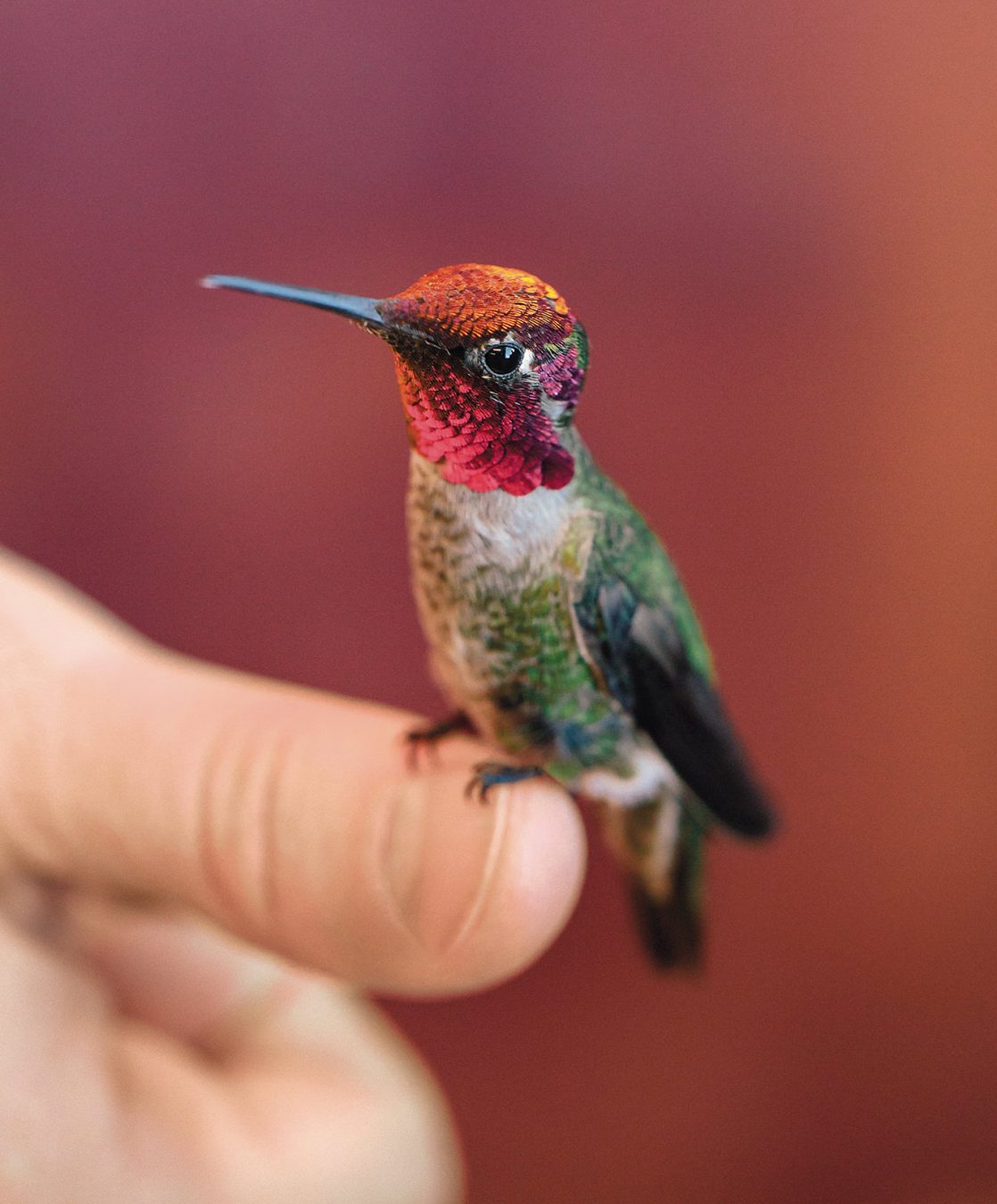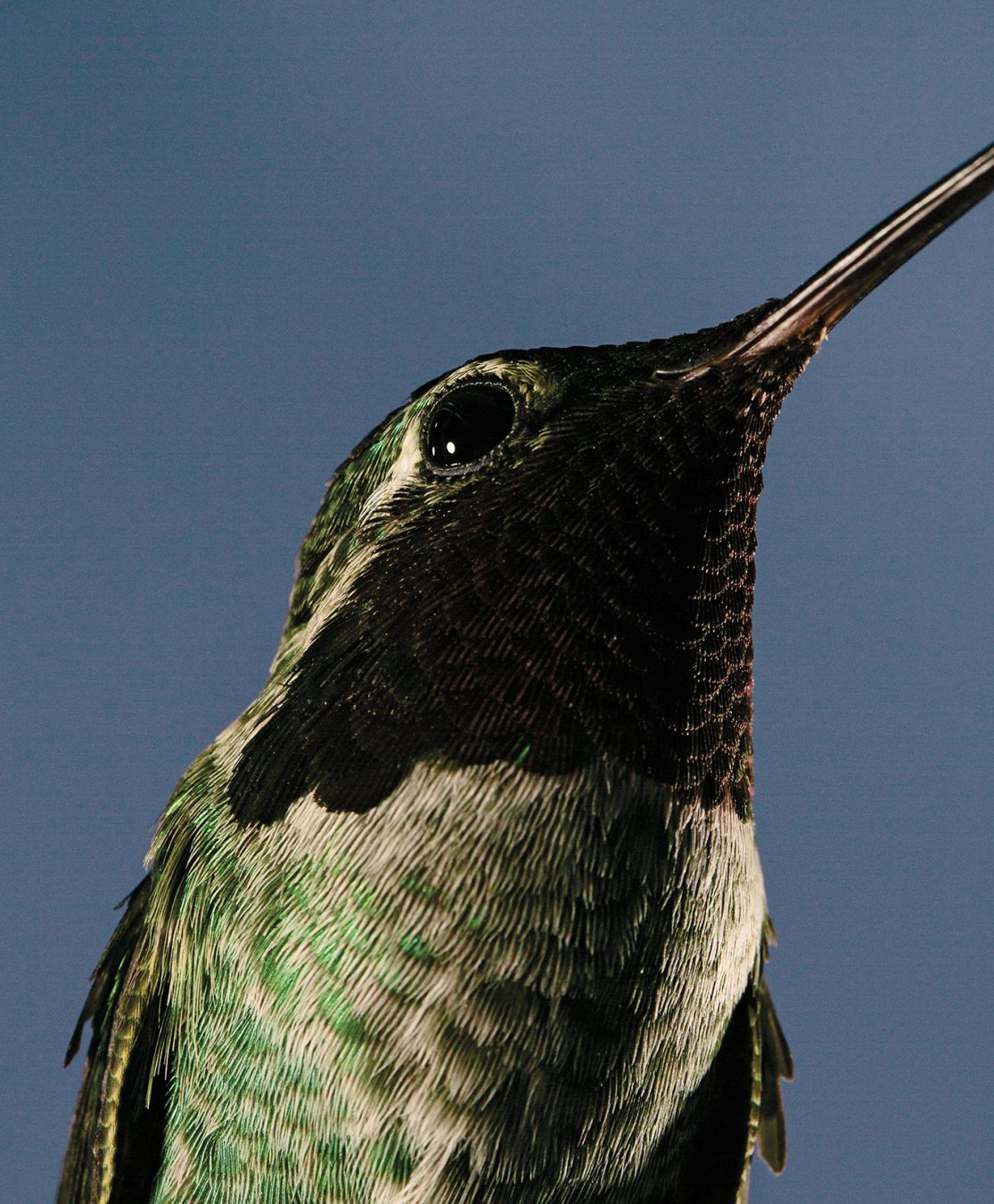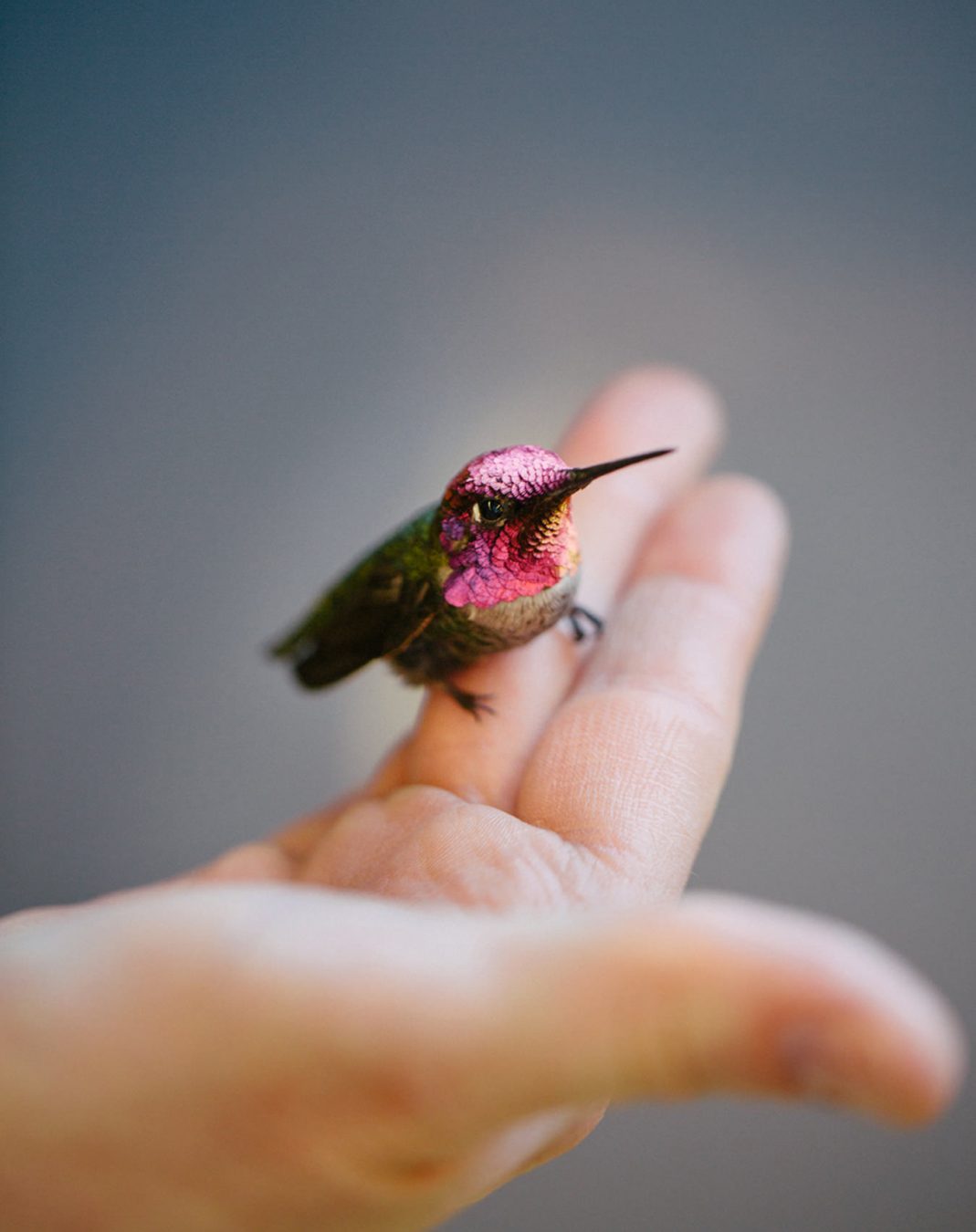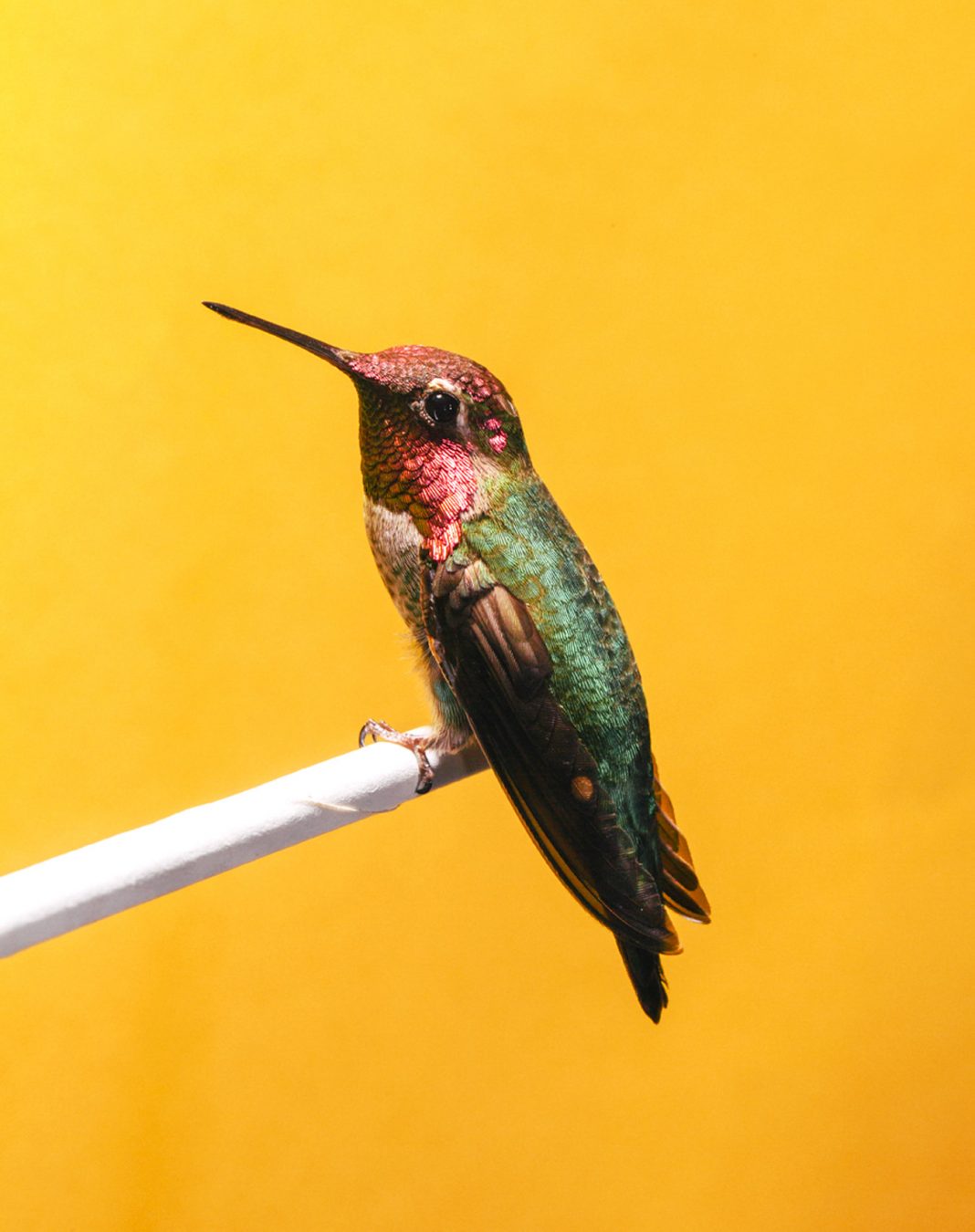Inside a darkened room at the University of British Columbia, zoologist Doug Altshuler watches a hummingbird hovering inside a virtual reality flight chamber. As the tiny green bird feeds from a plastic feeder, Altshuler presses a computer key, and a projected image on the flight tunnel’s walls begins to rotate. As it does, the hummingbird abruptly breaks contact with the feeder and drifts toward the projection. “He doesn’t like the motion,” says Altshuler. “He’s trying to get it to stop.” This experiment, part of an ongoing study into the role that vision plays in controlling the flight of Anna’s hummingbirds, has generated unexpected results. No matter where the projected images move on the tunnel’s illuminated walls, the motion always causes the hummingbirds to falter in mid-hover. Evidently, their visual-motion detection system is so sensitive that it can even override a critical behaviour like feeding. “This research is giving us new insights into the workings of the birds’ brains,” says Altshuler. “It’s a largely unexplored area.”
The physiology of hummingbird flight is a topic that has intrigued Altshuler for two decades. He describes hummers as “elite athletes,” a term that may seem incongruous when applied to a creature that weighs less than a nickel—but no other bird can match their aerial skills. These marvels of micro-engineering can fly forward, backward, sideways, straight up, and even upside down. They can hover for extended periods and perform complex aerobatics such as backward somersaults in mid-air. How exactly they manage these feats was not well understood until very recently. Yet while the development of high-speed video cameras and more sophisticated measuring tools are now allowing scientists to solve some of the secrets of hummingbird flight, others still resist decoding. If those black boxes can be unlocked, breakthroughs in engineering, medicine, and design may follow.
The early explorers called hummingbirds joyas voladoras (“flying jewels”), but concealed behind this shimmering veneer is a very tough and resilient bird. Although found only in the Americas, the 338 different species occupy a wide array of habitats from Alaska to Tierra del Fuego that range from deserts, to tropical rainforests, to high-altitude mountain slopes.
When flying, their wings flap up to 80 times per second, and their hearts beat up to 1,200 times per minute.
Everything about these birds is intense. They have among the highest metabolic rates relative to their size of any vertebrate animal. When flying, their wings flap up to 80 times per second, and their hearts beat up to 1,200 times per minute. In a typical day, they will visit 1,000 flowers, dining multiple times an hour, filling their tanks with high-calorie, sugar-rich nectar. They routinely ingest more than their weight in nectar each day; at night they sometimes enter a state of torpor, dropping their body temperatures and heart rates significantly.
Metabolism isn’t the only thing about hummingbirds that moves rapidly. When executing its kamikaze-like courtship dive, the male Anna’s hummingbird attains a speed of 60 miles per hour and hits nine G-force—enough force to cause an experienced fighter pilot to black out. These feathered dynamos also have astonishing stamina. Two of the five species found in Canada make gruelling migratory journeys: the rufous hummingbird flies 3,000 kilometres to Central America, while the ruby-throated hummingbird’s southerly route includes a brutal 18-hour odyssey over the Gulf of Mexico.
Their physical grit is matched by their attitude; hummers are so fearless that they have been observed attacking much larger birds. Highly territorial, the males will aggressively defend flowers and feeders, leading to dramatic mid-air tussles and occasional beak stabbings. Gram for gram, they may be the most cantankerous creatures in nature. As Altshuler notes: “One of my fellow researchers, Sheri Williamson (a director and naturalist at the Southeastern Arizona Bird Observatory), said that if hummingbirds had human language, their vocabulary would be 100 per cent swear words.”
Altshuler’s interest in hummingbirds began when he was a graduate student at The University of Texas at Austin, where he explored the various ways that physiology influences animal behavior. He continued his investigations at the University of California, Riverside, before transferring to UBC in 2011, attracted by the university’s “world-class zoology department.”
“Everything we’re doing here today is new.”
Today, his lab is one of a select few that employ live hummingbirds on a regular basis. In a happy coincidence, one of his test subjects, the Anna’s hummingbird, is a year-round resident in Vancouver. The Anna’s, which are named after a 19th century Italian duchess, are captured in traps and then trained for their lab duties. “We normally release them after three months,” explains Altshuler, who notes that hummers make excellent test subjects because they are smart and small, with superb memories and a strong drive to obtain nectar.
A significant part of Altshuler’s studies have also been conducted in the field, most notably in South America. In 2014, he was filmed demonstrating hummingbird agility in the cloud forests of Ecuador for a David Attenborough-narrated documentary entitled Conquest of the Skies. In the late 1990s, while pursuing his PhD, he journeyed to the Peruvian Andes; there, he captured (and then released within one or two hours) just under 400 individual hummingbirds in mist nets and put them through lifting trials and flight tests to determine how their flying abilities were affected by the thinner air of higher elevations.
Inside his university lab, Altshuler has created visual images of the hummingbirds’ aerial wake by photographing them as they buzz through laser-illuminated particles of olive oil. To gauge their strength and agility, he has tested these airborne ninjas while they wear a necklace of weighted beads or are buffeted by wind, and he has analyzed how they can maintain steady turns with a rapidly revolving feeder. “Everything we’re doing here today is new,” says Altshuler, who believes that the study of hummingbird flight has important future implications for medicine by illuminating the mechanics of neuromuscular control that goes awry in certain human disorders. He also sees the work leading to advancements in the design of airplanes and helicopters. In addition to military applications, the devices have the potential to be used in storm chasing, surveying, agriculture, and search and rescue.
“It’s strange,” says Altshuler. “I thought I’d be done with hummingbirds once I finished my PhD 15 years ago. But instead of exhausting the subject, we keep discovering new things. It’s an incredibly exciting time to be studying these creatures.”
Like this story? Read more on science and medicine.
















